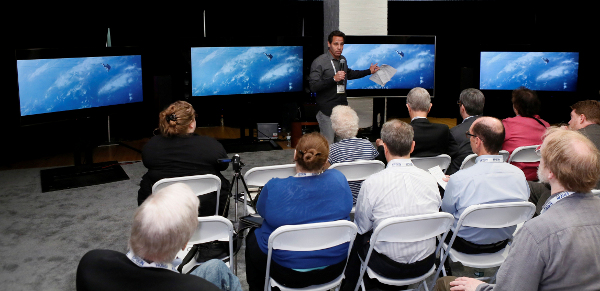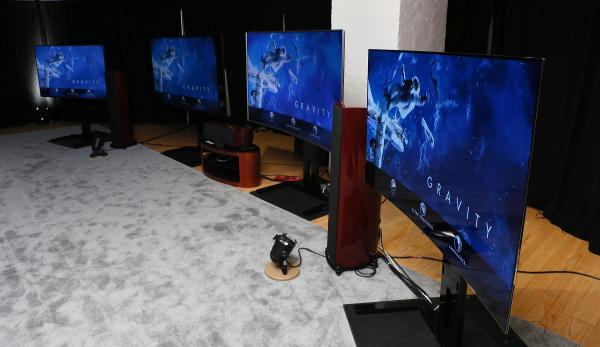LG’s 4K OLED Wins 2015 Value Electronics TV Shootout
LG Electronic’s organic light emitting diode (OLED) technology has taken the top spot at Value Electronics's annual HDTV shootout for the second year in a row.
The event, now 11 years running and typically held at Value’s Scarsdale, NY retail outlet, puts each year’s most advanced displays against one another in controlled conditions and asks attendees to vote on different aspects of the contenders’ image quality. This year’s Shootout was held in New York City as part of the CE Week trade event, with show attendees participating in a series of 1.5 hour presentations over the course of two days.
A total of 72 ballots were cast, not including a small handful of “expert” votes from those identified as TV reviewers or calibrators. All the TV’s were expertly adjusted by respected calibrator David Mackenzie. I was a technical presenter for three of the five sessions, leading attendees through the various evaluations, while Scott Wilkinson of avsforum.com presented the other two.
LG’s winning 65-inch 65EG9600 Ultra HD-resolution OLED was faced off this year against three LCD UHD models: Samsung’s 78-inch UN78JS9500 (2nd place); Sony’s 75-inch XBR-75X940C (3rd place), and Panasonic’s 65-inch TC-65CX850 (4th place). In a sign of the times, there were no 1080p models in the mix this year, and no plasma displays following that technology’s disappearance from the market in 2014. (Last year, Samsung’s F8500 plasma shared honors with LG’s 55-inch 1080p OLED, the 55EC9300.) Also absent were two models that would have been worthy of including but simply were not available: Sharp’s flagship LC-80XU30 model, and Vizio’s as-yet-unreleased Reference Series display.

The sets were judged on the following criteria:
- Black Quality – black purity and shadow detail
- Perceived Contrast – overall contrast and “punch” of the image when dark and bright elements share the same screen
- Color Accuracy– the set's ability to accurately display natural colors
- Off-Axis Performance – an area of concern primarily with LCD-based displays
- Screen Uniformity – how evenly the display reproduces light across the entirety of this screen
- Motion Clarity – degree of blurring and loss of resolution on moving objects
- Day Mode – how well the set rejects ambient light and retains contrast in brightly lit rooms
The results for both the regular attendees and experts (below), were calculated by first averaging all the valid scores for each TV in each given category. Then, scores from all seven attributes for each TV were added together and averaged to determine an overall winner. There was no weighting of categories—Motion Clarity, for example, held the same weight as Black Quality.


The final voting reflected what was obvious to me and other attendees—none of the sets performed the best in every category, and the results were ultimately pretty close among the top three ranking sets. What carried the LG OLED to victory was its strong Black Quality, Perceived Contrast, and Off-Axis Performance scores. These are the strengths of emissive OLED technology: the ability to fully turn off pixels on demand to create true black, the subsequent contrast and punch that comes off screen, and the same, relatively wide viewing angle that plasma and CRT displays always enjoyed.

What the Black Quality scores belied was a fairly subtle crushing of shadow detail on the LG with the darkest signals just above black; it was apparent on the pluge test pattern shown to participants, but went largely unnoticed. Much more significant was an obvious issue with screen uniformity in which the left and right edges of the LG’s screen blackened and began closing in on the image when playing challenging dark scenes with a low overall brightness level. LG’s representative was called on to address this repeatedly during the Q&A sessions, and said that the company is aware of the unusual behavior and is working on a fix.
I should note that this is not something typical of OLED technology per se, and we’ve never seen it in any prior OLED evalution we’ve done, so we assume it’s an abberation with this particular model. The LG OLED’s low scores in the Screen Uniformity category reflected this problem, but it didn’t seem to matter in the final analysis. The striking nature of the set’s contrast, perhaps aided by the fact that many in attendence were able to see that performance even while sitting far off axis from the LG’s screen, allowed it to coast to victory. In the naming of favorites, the LG captured 36 votes among those who gave a valid response, while the Sony took just 16, the Samsung 15, and the Panasonic just one.
In Panasonic’s defense, their entry was simply outclassed here by much more expensive competition, even accounting for the larger screen size of the two LCD contenders and the OLED’s significant cost premium. With a $3,500 list price, the TC-65CX850, this year’s top-of-the-line, is designed to hit a high level of performance at a high-volume price point rather than function as a statement piece. The difference became most apparent in the necessary compromises made to its backlight—the expensive competition squashed it on blacks and contrast in this side-by-side comparison.




















































